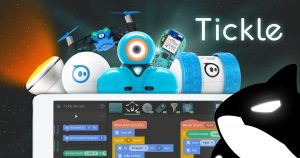Subject: Digital Technologies
YearLevel: 3-4, 5-6
Links to other Learning Areas: Literacy, Numeracy, The Arts, and Science
Links to Cross Curricular Priorities/ General Capabilities: Numeracy, Critical and Creative Thinking, ICT.
Platform: iPad App
Cost: Free
ACARA Links:
- Design, modify and follow simple algorithms involving sequence of steps, branching, and iteration (repetition) (ACTDIP019)
- Implement simple digital solutions as simple visual programs involving branching (decisions) and user input (ACTDIP011)
- Examine the main components of common digital systems and how they may connect together to form networks to transmit data (ACTDIK014)
- Identify and explore a range of digital systems with peripheral devices for different purposes, and transmit different types of data (ACTDIK007)
What is it?
Tickle is a free app that enables you to program various programmable robots and air drones, as well as supporting resources.
How is it used?
Tickle uses visual programming to enable you to control programmable robots including the Star Wars BB-8 Droid, Sphero (SPRK) robotic ball, Ollie 2-wheeled robot and the Dash and Dot robots. You can also control drones such as Parrot Rolling Spider, Airborne, and Jumping Sumo mini drones. Tickle enables you to connect multiple devices together so that they can interact with each other as well as create your own programs using the visual programming blocks in Orca.
Skills developed
Create interactive games and stories
Coding
Computer language
Software knowledge
Want more information on Tickle?
https://tickleapp.com/








